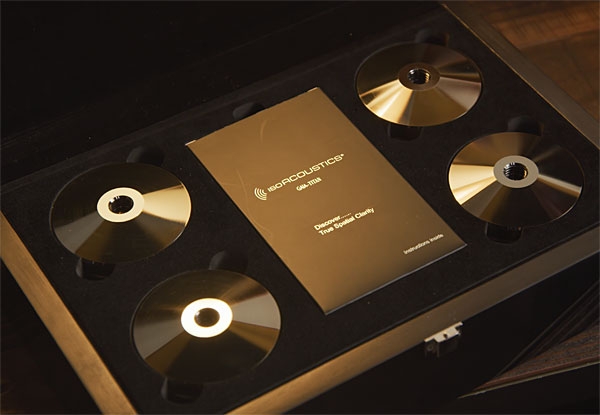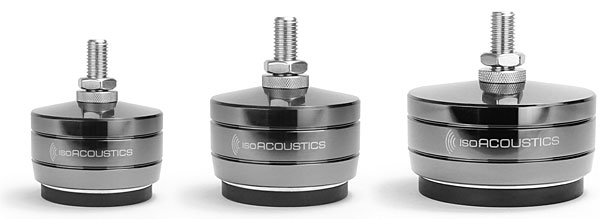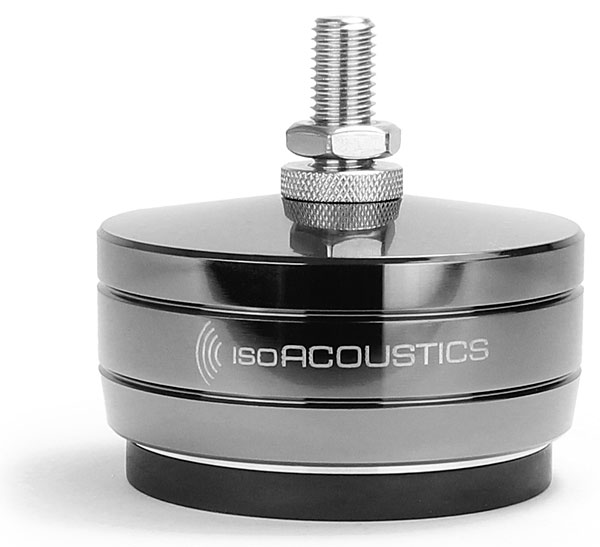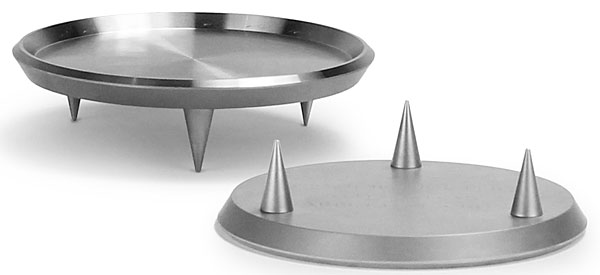| Columns Retired Columns & Blogs |
... Dave Mason isn't worn out, either.
https://www.youtube.com/watch?v=Xd56ap_aa4k

Isoacoustics Gaia-Titan Cronos
I can write about the IsoAcoustics Gaia-Titan Cronos loudspeaker footers (footnote 1) because I did the evaluation before swapping out the big Wilsons for the Duos and then listened again once the Alexxes were back in the system, to reassure myself about what I'd heard.
At the Expert Imaging and Sound Association's (EISA) 2019 convention in Antwerp, Belgium, IsoAcoustics put on a startling demonstration. Journalists from around the world attend the EISA event, where manufacturers demonstrate various products, from amplifiers to cameras. Later, votes are taken and awards are handed out. This year, there was no convention: Auditions and deliberations were carried out locally, with proper social distance. As I write this, Stereophile has just posted the 2020–2021 EISA Award winners on its website.

At the pre-COVID 2019 EISA convention, IsoAcoustics set up two pairs of modestly priced floorstanding speakers, side by side. One pair sat on the stock spikes, the other on a set of IsoAcoustics feet, the particular model of which I don't recall. (IsoAcoustics makes different models for different loudspeaker weights.) A simple switch directed music to one set of speakers or the other, allowing a rapid A/B demonstration.
The differences I heard were remarkable. Everyone in the room heard it. Some didn't believe what they were hearing. Some even assumed the fix was in. My incredulity led me to insist that presenter and company president Dave Morrison reverse the speaker pairs in case room acoustics were playing a part in what everyone heard. Morrison did as I asked. The big differences remained.
Impressed, I asked for some Gaias to try under my Wilson Alexxes. Soon, two sets of Gaia-Titan Cronoses arrived. Each set of four feet has a list price of $1599.99 and is capable of supporting 620lb. (The Cronos is the largest Gaia-Titan model, made for the heaviest speakers.) Later, when Morrison found out my speakers sit on carpet over concrete, he sent along sets of multispiked carpet discs.

Each set of four footers comes packed in a hinged, piano-black lacquer box containing the feet and three sets of screw-in threads in different sizes to fit a wide range of loudspeakers; other sizes are available upon request. A small wrench is included for screwing in the correct set for your speakers, which then lock in place with a knurled circular nut. A hex nut screwed on atop the knurled nut secures the footer to the speaker bottom by screwing it upward to tighten. All this adjustability is necessary because the feet are directional: For best isolation, you place them with the logo facing either forward or backward to align with the speaker's "motive energy," the directions in which the drivers move. Once the speakers are level, the logos are facing forward or back, you screw up the hex nuts to fully tighten the foot.
I'm not the first Stereophile reviewer to write about IsoAcoustics footers. Robert Deutsch got the early scoop in the September 2017 issue. Art Dudley then wrote about them, too, trying them under his Garrard 301 turntable. Jim Austin wrote about a demo he experienced—much like the EISA demo—at the 2019 Munich High End audio show, and then wrote about his experiences with the footers under the Revel Ultima Salon2 loudspeakers in the October 2020 issue of Stereophile. Gaia feet won a Stereophile 2019 "Product of the Year" award.

The usual skeptics posted under Jim's account of his Munich experience; at least one poster suggested that the room placement differences might have accounted for what he heard. That was my thought, too, when I heard the EISA demo, so I insisted on the swap and then was convinced. What's more, you'll find a video on the IsoAcoustics website made by PS Audio's Paul McGowan in which you can easily hear the differences in a similar demo recorded through a camera microphone at RMAF 2018! It is not a subtle difference. In fact, it's so clear and obvious that skeptics are likely to assume fraud.
There's also a link on that page to an explanation of how this patented product works and the measurements done at the National Research Council of Canada.
Everything I heard under lousy hotel room demo conditions was 10× more dramatic at home. It was not at all subtle. These feet remarkably reduced (I'd say "eliminated" but another product might come along and take this to yet another level) "smear" and "blur" that I was completely unaware was there. One of the problems with this job is that the descriptive words we use like "focus" and "detail" (you can list the rest) correspond to no direct mathematical or measurable quantity. I know my speakers in my room produce exceptional image focus, specificity, three-dimensionality, and so on because that's the first thing visitors notice—including visitors with much experience with high-end sound. It's like, "Boing"! Especially notable are the responses I see from people who typically are anti-Wilson but who have never heard Wilson speakers under proper conditions. (I've heard Alexxes sound positively awful at shows.) After a minute or two, they say "Oh! I get it now! Wow!" (Boing!)
After I put the speakers on Gaia Titan Cronos feet, the improvement in low-level detail, resolution, image focus, clarity, bass attack and decay, and transparency were—I'll write it again—not at all subtle. They were huge! I swear that's not hyperbole.
I've been playing the original "pink label" British pressing of Traffic's second album (Traffic, UAS 6676, 1968) for 52 years. I never tire of listening to the mix of jazz, humor, and Dave Mason's unerring melodic rock songs. I thought I'd reached the limits of what could be extracted from that record, but with the Gaia Titan Cronos installed I heard things on "Feelin' Alright?" I've never before heard, especially background vocal asides and assorted percussive accents. The clarity of some cowbell hits startled, both timbrally (more metal) and spatially (right there), as did the overall ease of the presentation.
I played both Tidal and Qobuz 16/44.1 versions, too. While the Qobuz beat the Tidal, with a more supple quality overall, both sounded like cardboard compared to the old record—and that track is the last track on side one, where vinyl is supposed to have a huge disadvantage—never mind that the record must be worn out after 52 years of play (but isn't). That's the only example I'll cite, but even (perhaps especially) mono records produced a locked-in center image that far surpassed what I thought was already a solid center picture.
As for timbral changes, the bottom end of my speakers noticeably tightened up and produced greater extension, which affected everything above. The bottom end of Thom Yorke's bass-rich Anima (XL 987) was noticeably more compact, with more punch. That freed up the midrange and produced a more open and clearer presentation.

... Dave Mason isn't worn out, either.
https://www.youtube.com/watch?v=Xd56ap_aa4k

Ha Ha! crazy audiophiles buying $3200 footers to improve the sound of their speakers. The question that should be asked to the speaker manufacturers as to why we have to spend MORE money to hear better sound from their speakers when we have already paid for it. Why are these footers or equivalent or their equivalent feature not in their speaker? Why were the speaker guys sleeping at their posts? They probably will say it is unnecessary. Same as buying $3000 speaker cables to get an audio signal from an amplifier to a speaker 4 ft away, boy those speakers but be poorly designed.

Using larger box British BBC monitors with high mass "anchor" stands spiked to concrete (through carpet), my situation is much different than floor standing speakers.
I have another variable to contend with- the isolation "dot" between stand and speaker. And man, do they make a difference ! I just completed a shootout with many different "dot" materials and sizes- sorbothane, hard silicone rubber, softer silicone rubber, cork, etc.
I would not mind isolating the stands but don't want it to ruin the "dot" synergy I have.

... various speaker/stand interface materials in this report:
https://www.stereophile.com/features/806/index.html

Hi
I've done both ways for my KEF 2-way stand speakers:-
(1) the BBC monitor way - spiked tripod on the wall-to-wall carpeted concrete basement floor of my audio den.
(2) isolation flat "dots" made of quarter-sized semi-hard silicon round pads between the tripod & the loudspeaker cabinet base.
The "dots" adds more body to the low-mid spectrum which was cleaned up by the tripod on spikes. Well balanced.
Jack L

Hi
What a bold claim !
First off, why Boisclair used a shiny glass disc for his demo & denounced grooveless disc should not be used for anti-skating test ? Don't tell me he does not know the surface friction of a smooth glass disc is next to nothing vs a grooveless test disc made of vinyl, same material used to stamp the music LPs since day one decades back.
So London FFSS produced & sold tons of test vinyl LPs (with grooveless tracks to anti-skating test) decades back did not know what it was doing???
I got one such London FFSS test record & have used the grooveless track there to test anti-skating of turntable/tone arm combos since day one decades back.
As per Boisclair, I have been doing the test "wrong" ! Being "wrong" because of not using the tractors Boisclair supplied.
Give me a break, please!
My expensive SME black fiberglass tone arm/moving coil cartridge, which I dismantled completely, repaired & reinstalled back on my direct-drive TT, now tracks the grooveless track of my London FFSS test record perfectly after its alignment using my simple tools. So I have done its anti-skating "wrong" because I did not use the tools supplied by Boisclair !!!!
So will Boisclair please school me how?
Jack L

... is made of black fiberglass?

Hi
Correction:
It should be London FFRR test record: "How to give yourself a stereo check out".
Jack L

For what it's worth, I tried these with Vandersteen Treo CTs a while back. When I emailed Vandersteen to ask how I should adjust the speakers to accommodate them (they use a system of washers on the rear center spike to aim the tweeters at the listener's ears), Richard called and gave me a long explanation of why he believes his speakers, at least, should be firmly anchored to the floor with the spikes and washers he provides, thus ensuring accurate phasing alignment. I sent the IsoAcoustics back and was more pleased with the result. Your mileage, etc.

"There's also a link on that page to an explanation of how this patented product works"
On what page? Tried the Isoacoustics site and did not spot the explanation of how they say these work. No idea what page is being referred to, either. Could you please make this simpler by supplying the link, TIA?

decoupling a mass from a floor essentially lowers the mass of the entire system ( raising the system's resonant frequency ).
It's audible, for better or worse.
The only thing I've noticed not making any noticeable change to system performance is Speaker Cable trusses.
Is there a Loudspeaker Manufacturer 'improving' their Loudspeaker offerings with this technology?, I'm not aware of any but I'd like to see one or even many report great things from a new floor suspension option.
Where is Wilson on all this?, where is Magnapan, Magico? where are the big Pro-Audio people ?
On the other hand, P&A ( parts & accessories ) are an important contributor to Retail Dealer Profits.
Better Shock absorbers improve ( or change ) performance.
For what it's worth, 3M make this sort of device bubble packed, Home Depot, Lowes and Hardwares Everywhere.
It might be fun to AB test a bunch of these devices ( especially if helped by a serving of enhanced Brownies ).
Tony in Venice

...... system performance is Speaker Cable trusses." quoted tonykaz
I've got ALL floor lying cables, ie: power cables (including 4 dedicated CONDITIONED power lines from my house main power panel to my audio rig), speaker cables, elevated 4" above the fully-carpeted concrete floor of my basement audio den, using small semi-rigid cellular foam blocks spacing 6" apart along the whole way.
Technically, it is a very sound measure:
(1) The foam block cable suspenders serve to absorb any vibrations due to close-by footdrops & loudspeaker soundwaves at high volumes.
(2) There are miles & miles of utility power cables concealed behind the walls, & underneath the floors of any house/building, forming a huge antenna loop to receive & re-transmit RFI/EMI noises which are made worse with WIFI.
Concrete floors are the worst RFI/EMI noise situation: the reinforcement steel bars buried inside the poured concrete form a powerful antenna for the unwanted RF noises.
So ALL floor lying UNSHIELDED cables must be elevated from the concrete floor surface to minimize the RF noises transmitted from the steel bars buried inside the concrete floor. So cable suspenders are a MUST !!!!
To ensure my bi-wired loudspeaker cables to immune from the RF noises, I
added an inline RFI/EMI nosie suppressor onto each of cables, 4 of them totally.
Listening is believing
Jack L

You reveal a complex system and understanding.
I simply state that I've never noticed any difference ! ( it could be that I've tuned it out )
Years ago I represented Monster Cable and carried thier entire Line of Cable accessories. Folks buy and like Trusses.
and
you probably are a more sensitive audiophile than me.
For me, music is an imperfect life companion that can Mood-alter if I ask to.
and
my shirt pocket Audiophile systems don't need trusses.
Tony in Venice

Hi
Bingo!
Jack L

...... of the entire system ( raising the system's resonant frequency ). quoted Tonykaz
Hi
Nope.
If the spikes are pointing DOWNWARDS in contact of the floor, the point contacts increase the object effective mass big big time, thus lowering its resonance frequency.
You will find it will clean up the overall audio spectrum of the sound distinctly, delivering much more details, transparency, & precision imaging. This improvement happened to mine.
As already posted above, I've also isolated my KEF 2-way loudspeaker cabinet from the spiked steel tripod stand with 4 silicon rubber pads. It enriches the mid-low spectrum of the music.
Listening is believing
Jack L

This is a place where I'd ask John Atkinson to measure Loudspeaker performance with these devices.
Jim Theil had some of his range of loudspeakers drilled out for 1/4" dowel spikes but refrained from endorsing their use. I've used and not used with pleasing results, I prefer no spikes or even casters.
I'm just not a tweaky, hair shirt Audiophile. I loved Meridian Active Loudspeakers enough to Import their entire Range.
If Stereophile is going to continue to endorse these Iso Feet Suspensions I'd like some measurements explaining what's happening. ( I can certainly live without it )
and
I wonder if they will make my Maytag Washer's Rinse cycle run any less bumpy-whobbly ?
Tony in Venice

Hi
Bingo!
Jack L